11.20 Dresden: Florence of the North
Early history
Situated in the east of modern Germany on the River Elbe, Dresden was first mentioned in official documents in 1206. The city derives its name from "Drezdany", the name of a village inhabited by Sorbs, and which literally means "the people from the marshy forest". It quickly became the capital of Saxony (in German: Sachsen), which became a major European power in 1697 when August the Strong of Saxony converted to catholicism and gained the Polish crown. Dresden became known internationally for its elaborately-decorated china which was manufactured from 1710 onwards in nearby Meißen.
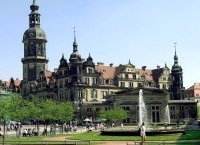 |
| Picturesque Dresden |
|
In 1806 French troops occupied Dresden, and the city was the scene of Napoleon's last great military victory in August 1813 when 23,000 enemy soldiers died as French troops defeated Austrian forces under the command of General Schwarzenberg. Dresden grew quickly in size during the 19th Century and had a population of 632,710 by 1930 - by which time of course Saxony had become part of a unified Germany.
The air-raid on Dresden in 1945
In 1945, during the latter stages of World War II, Dresden was perceived by the Allied forces to be a pivotal centre of communications as the Allied commander-in-chief General Eisenhower was anxious to link up with the advancing Red Army in south Germany. Many factors spoke against it being a bombing target however. Dresden was a beautiful Baroque city known as the "Florence of the North". It had no war industry and little military value. The city was known to be overcrowded with some 200,000 refugees, mainly peasants from Silesia fleeing the Red Army.
Despite this however, it was believed that air attacks on Dresden would sap the morale of the German populace and also provide retaliation for German attacks on London and other British cities. On the night of 13-14 February 1945, heavy and sustained air-raids were launched on Dresden by Britain's Bomber Command. 805 bombers dropped a total of 2690 tonnes of bombs on the city, followed by three more in daylight by the US 8th Air Force.
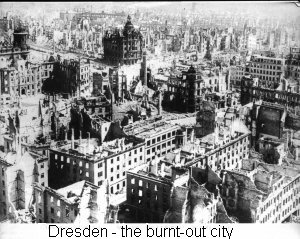
A firestorm engulfing eight square miles flattened over 30,000 buildings, including many of great cultural importance such as the Frauenkirche (Church of Our Lady). The numbers of those who died in the bombing and the ensuing firestorm are still in dispute, with estimates varying from 55,000 to 250,000. Whatever the figure, it was probably greater than the 51,509 British civilians killed by the Luftwaffe during the whole of the Second World War and the 70,000 immediate deaths at Hiroshima after the dropping of the first atom bomb on 6th August 1945.
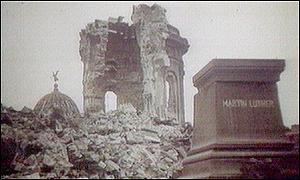 |
| The aftermaths of the 1945 air-raid |
|
1949 to the present day
After World War II, Dresden found itself in the Soviet occupation zone and thus became part of the German Democratic Republic. Saxony was dissolved as an administrational area and replaced by three regions: Dresden, Leipzig and Chemnitz. The city was located in what once was called the Tal der Ahnungslosen (Valley of the Clueless) - as the city is encircled by mountains and hills, the signals of the West German TV stations never seemed to reach peoples antennas, forcing them to watch the television channels of the socialist state broadcaster. German reunification in 1990 saw the reinstatement of Saxony as a German Land, with Dresden once again as its capital.
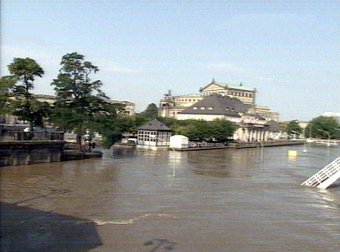 |
| Dresden is flooded in August 2002 |
|
In August 2002 large areas of Dresden were flooded, first by the Weißeritz river and then by the River Elbe. The Elbe, which has a normal summer level of around two metres on its way through Dresden, reached a height of over nine metres, thus beating the all-time high of 1845. 35,000 people had to be evacuated and 100,000 people were without electricity. The basement of the 19th-century Semper Opera House (pictured below) was filled with water to a depth of almost three metres, although most of the cultural artefacts in the building were thankfully brought to safety. The biggest clear-up operation in Dresden since 1945 cost the city millions of euros.
Size and architecture
Dresden currently has a population of 472,350 inhabitants, which makes it the fifteenth biggest city in Germany. The city owes its reputation as the "Florence of the North" to the baroque period, when it became one of the most glamorous European royal capitals. This period witnessed the construction of many of Dresden's most beautiful buildings such as the Zwinger, the Hofkirche and the Schaumburgpalais. Dresden's highlights include the magnificent palatial buildings around the Theaterplatz and the Brühl Terrace, and the many art treasures at the state museums.
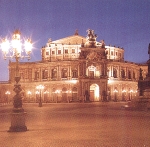 |
| Semper Opera House |
|
The reconstruction of Dresden's elegant landmarks after the air-raids of August 1945 was largely neglected by the GDR authorities. Inner-city areas that had only been lightly damaged by the bombing were largely left as they were. Instead a series of Soviet-style concrete buildings and housing blocks were added in areas such as Johannstadt, Gorbitz and Prohlis. Until 1989 the architecture of the city constituted a harsh contrast between decaying baroque splendour and concrete functionalism.
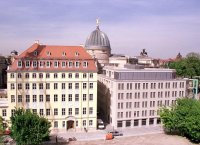 |
| "Functionalist" Dresden? |
|
 It was only after reunification in 1990 that large scale reconstruction of the city got underway. Work was started in 1994 to rebuild the Frauenkirche (see picture left), the 18th Century baroque church at the heart of Dresden which had been in ruins since the bombing raids of 1945. Restoration work was completed in 2005, a year ahead of schedule, and the church was reconsecrated on 30 October 2005, with festive services lasting through the Protestant observance of Reformation Day on 31 October. The new Frauenkirche formed a fitting symbol for Dresden's 800th anniversary in 2006 and an exhibition on the history and reconstruction of the church can be seen at the Stadtmuseum (City Museum) in Dresden's Alten Landhaus until the year 2010. Click here to see a live webcam of the Frauenkirche. It was only after reunification in 1990 that large scale reconstruction of the city got underway. Work was started in 1994 to rebuild the Frauenkirche (see picture left), the 18th Century baroque church at the heart of Dresden which had been in ruins since the bombing raids of 1945. Restoration work was completed in 2005, a year ahead of schedule, and the church was reconsecrated on 30 October 2005, with festive services lasting through the Protestant observance of Reformation Day on 31 October. The new Frauenkirche formed a fitting symbol for Dresden's 800th anniversary in 2006 and an exhibition on the history and reconstruction of the church can be seen at the Stadtmuseum (City Museum) in Dresden's Alten Landhaus until the year 2010. Click here to see a live webcam of the Frauenkirche.
Dresden information portals
Dresden Newspapers
Dresden Listings Magazines
Radio Stations in Dresden
 Chapter 11: Exercises Chapter 11: Exercises
 Nach oben Nach oben
 Print This Page Print This Page
|